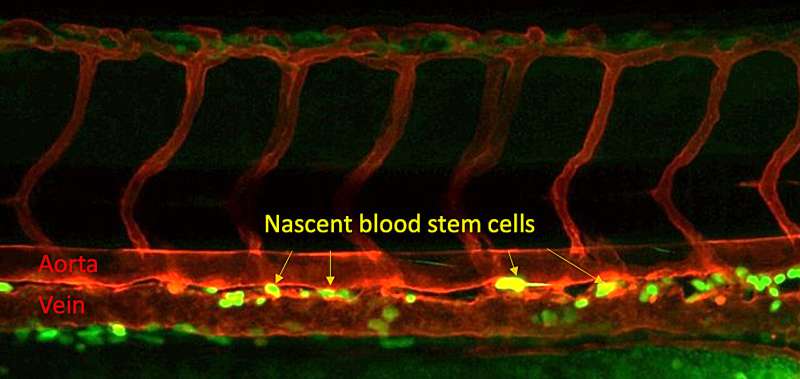This article has been reviewed according to Science X's editorial process and policies. Editors have highlighted the following attributes while ensuring the content's credibility:
fact-checked
peer-reviewed publication
trusted source
proofread
Researchers discover crucial step in creating blood stem cells

A microbial sensor that helps identify and fight bacterial infections also plays a key role in the development of blood stem cells, providing a valuable new insight in the effort to create patient-derived blood stem cells that could eliminate the need for bone marrow transplants.
The discovery by a research team led by Raquel Espin Palazon, an assistant professor of genetics, development and cell biology at Iowa State University, is published in Nature Communications. It builds on prior work by Espin Palazon showing that the inflammatory signals that prompt a body's immune response have an entirely different role in the earliest stages of life, as vascular systems and blood are forming in embryos.
Espin Palazon said knowing that embryos activate the microbial sensor, a protein known as Nod1, to force vascular endothelial cells to become blood stem cells could help develop a method to make blood stem cells in a lab from a patient's own blood.
"This would eliminate the challenging task of finding compatible bone marrow transplant donors and the complications that occur after receiving a transplant, improving the lives of many leukemia, lymphoma, and anemia patients," she said.
A critical cue
Stem cells are both the factories and the raw materials of a body, repeatedly dividing to self-renew and build new cells for specific tissues. Pluripotent stem cells in embryos can make any kind of cell a body needs, while adult stem cells are limited to producing particular types. Blood stem cells, or hematopoietic stem cells, make all of the blood's components. A lifetime supply of blood stem cells is created before birth inside an embryo.
The immune receptor Espin Palazon's team identified activates in an embryo before endothelial cells start becoming stem cells, priming them for the transition.
"We know blood stem cells form from endothelial cells, but the factors that set up the cell to switch identity were enigmatic," she said. "We didn't know that this receptor was needed or that it was needed this early, before blood stem cells even form."
Researchers zeroed in on Nod1 by analyzing public databases of human embryos and studied it using zebrafish, which share about 70% of their genome with humans. Blood stem cell creation tracked closely with Nod1 levels as its effects were inhibited or enhanced.
To confirm Nod1 also plays a role in human blood development, the research team worked with the Children's Hospital of Philadelphia. Researchers there produce human-induced pluripotent stem cells, which are generated from mature samples but genetically reprogrammed to behave like the make-anything stem cells found in embryos.
Induced pluripotent stem cells can create most types of blood cells, though not functional blood stem cells. But when researchers took away Nod1, blood production faltered, as it did with blood stem cells in zebrafish.
Seeking self-derived stem cells
Figuring out that Nod1 is a prerequisite for blood stem cells to develop is progress for scientists hoping to design a system for producing blood stem cells from human samples, which could offer a revolutionary new option for patients suffering from blood disorders. Instead of a life-saving infusion of blood stem cells via a transplant of bone marrow, the spongy insides of bones that hold most of a body's blood stem cells, patients could be treated with stem cells that originated in their own body.
Self-derived stem cells could avoid the risks of graft-versus-host disease, a common and potentially deadly reaction that occurs when a patient's immune system perceives the transplant as a threat to be attacked.
"This would be a huge advancement for regenerative medicine," Espin Palazon said.
Espin Palazon's team is continuing to untangle the complex interactions in which blood stem cells arise, including refining the timeline. Understanding when signals are expressed is essential to developing the methods for making blood stem cells.
"The timing is so crucial. It's like when you're cooking, and you need to add ingredients in a specific order," she said.
Further research will benefit from the collaboration with Children's Hospital of Philadelphia, which trained one of the study's co-authors—Clyde Campbell, adjunct assistant professor of genetics, development, and cell biology—on the protocols to create induced pluripotent stem cells.
"My group at Iowa State University will continue working towards a life without blood disorders. I believe our investigations will pave the road to finally create therapeutic-grade blood stem cells to cure blood disorder patients," Espin Palazon said.
More information: Xiaoyi Cheng et al, Nod1-dependent NF-kB activation initiates hematopoietic stem cell specification in response to small Rho GTPases, Nature Communications (2023). DOI: 10.1038/s41467-023-43349-1
Journal information: Nature Communications
Provided by Iowa State University





















